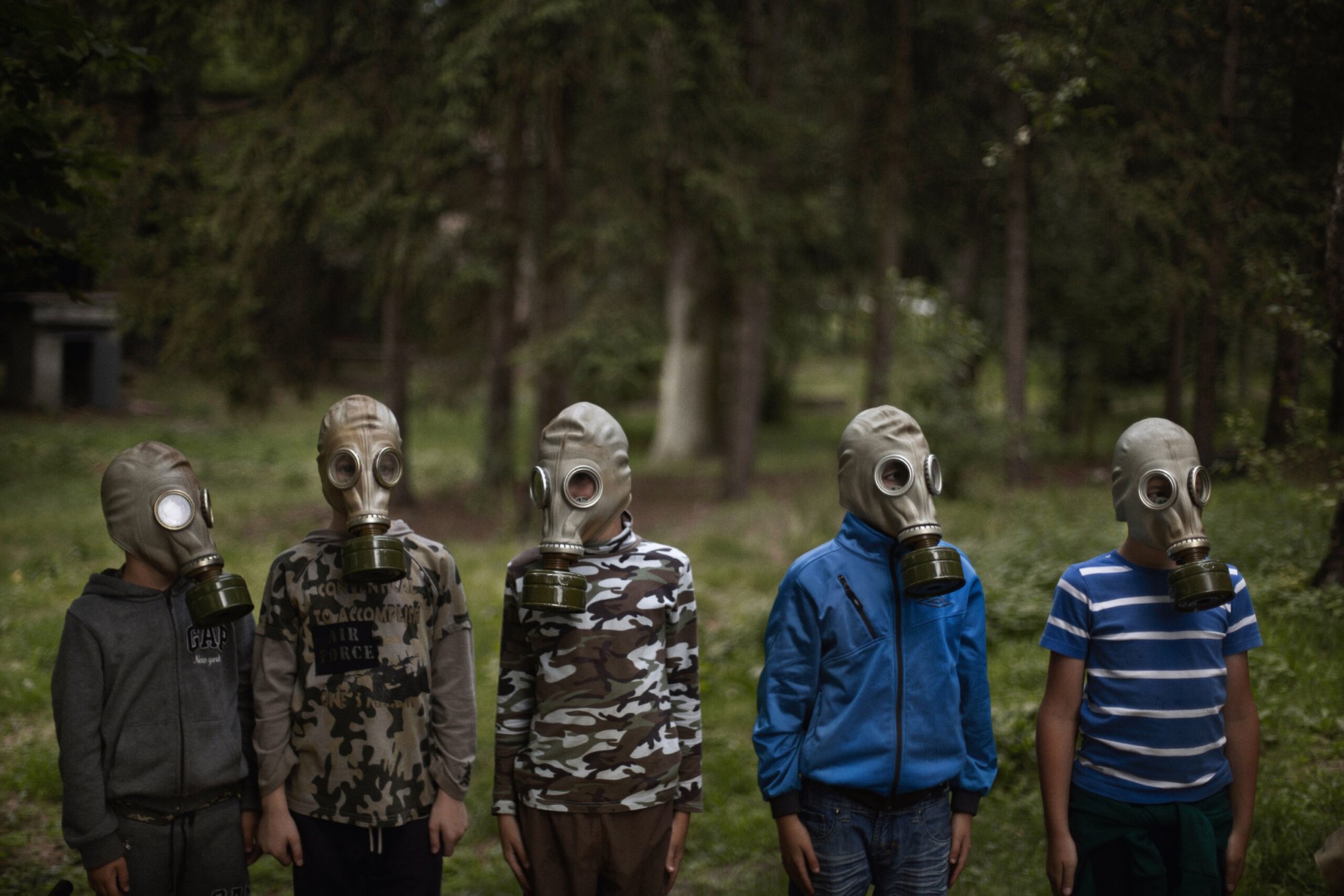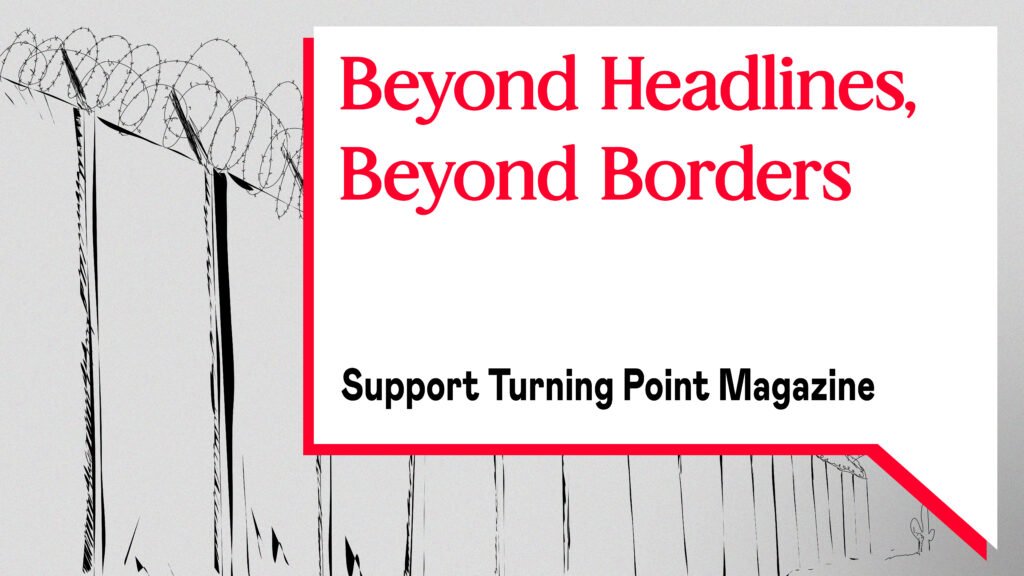Cover photo: Kyiv, Ukraine, July 16, 2018. A group of young Ukrainian boys are being taught how to put a gas mask on by Oleksiv Zabolotny, trainer of LIDER CAMP, a hyper-nationalist military summer camp in Kiev’s outskirts. ©Diego Ibarra Sanchez
There are 110 ongoing armed conflicts in the world. Almost half of them (56) are interstate wars, while the remaining are primarily fought by non-state belligerents. This is the highest number since WWII, but never before has the world seen so many antagonistic nations. At least 92 states are engaged in conflicts outside their borders.
We can say the “fog of war” has descended on the whole world. This expression usually refers to combatants’ inability to retain a clear picture on and off the battlefield. However, lately, many analysts have used it to speak of the general populations enveloping in wars’ fog. Misinformation, disinformation, and fake news have become ordinary words in our everyday vocabulary. If people are ill-informed, they can not make conscious decisions. And even when people are informed, their opinions, arguments, and even fundamental rights are increasingly suppressed with slurs such as “supporting terrorists” or “playing into Putin’s hands.”
As wars and civil conflicts ravage all continents besides North America, their social, humanitarian, and environmental impacts reverberate far beyond the conflict zones. In 2023, only the economic impact of pervasive warfare has reached $19.1 trillion globally, that is, $2,380 per person.
Notably, within the currently counted conflicts, the vast majority are just ignored or sidelined. We think of Sudan, for instance, which is the deadliest ongoing conflict in the globe. According to conservative estimates, at least 75,000 people have died in the conflict, and almost 13 million have been internally displaced. We think of Myanmar, which is four years into a civil war, or Ethiopia and Congo, where ongoing violence devastates communities. In Afghanistan, which endured a 30-year-long war, now under the Taliban regime, women are not allowed to speak in public anymore. The list is long.
At the same time, the ongoing genocide in Gaza is shaking the conscience of millions worldwide. There is no end in sight, as Israel is expanding the conflict beyond its borders.
While writing this editorial, Israel targeted Lebanon with a sophisticated attack, exploding 3,000 pagers and other communication devices held by Hezbollah members. Israel compromised the group’s supply chain with thousands of tiny explosives in the devices. The operation has been described as an “advanced” 21st-century attack and something new for warfare. Yet, in less than a week, it has led to all the predictable outcomes of conventional war, turning from spy fiction to Guernica in just a few days.
We are not impressed by its sophistication but rather shocked at the cynicism that allows the situation to unfold before the world’s eyes. In the end, the only genuinely novel aspects of this relatively old-fashioned SMS-triggered explosives operation was its indiscriminate and large-scale use.
Attacks like these have implications beyond the Middle East. It is illegal under international law and sets a precedent for other states that carry out assassination programs against their internal or external enemies.
Without enforceable actions against “supply-chain warfare,” protecting the innocent from tit-for-tat attacks will become a nearly impossible task. During the campaign that started with the exploding pagers, and continued with indiscriminate bombings of civilian neighborhoods, more than 1,000 people have been killed in Lebanon, with more than 6,000 wounded and one million—a fifth of the country’s population—displaced. These figures characterize what Israel has called “precise” and “intelligence-based” attacks against a handful of Hamas and Hezbollah leaders.
At Turning Point, we do not insist on “more proportional war” but on peace: no bombing, no assassinations, and no foreign interference.
It is a universal principle, and it does not only apply to Israel. It applies also to the Syrian regime, Iran via Hezbollah and the Houthis, the United States, European states like France and the UK, and Saudi Arabia. All have played a role in chipping away at Lebanese independence, but today, we must focus on stopping the driving force of the regional conflict. That force is Netanyahu’s government and its military forces.
At the time of writing, Israel has expanded its air raids not only in Lebanon but also in Syria and Yemen. A ground invasion is underway in Southern Lebanon. The standards of war that Israel established in Gaza are now exported to neighboring countries, followed by the same condemnation and collaboration from its ally governments. To stand for peace is to stand against bombing, shelling, and invasions, but also—and perhaps more importantly—against the international complicity that enables them.
Naturally, also other forces, including Hezbollah and Hamas, will face their own reckoning in the Middle East. To oppose this war is not to be ignorant of their crimes. Hezbollah’s current under-dog status does not redeem its actions in Syria the group intervened to preserve Assad’s regime— an intervention that included the brutal siege of Damascus’ Palestinian community (in Madaya and Yarmouk neighborhoods) which killed thousands.
The Islamic Republic of Iran has responded with hundreds of ballistic missiles against Tel Aviv. The risk of a full escalation into a regional war is very real. In the meantime, other wars remain far from the limelight.
This issue, Fog of War, highlights some of the ongoing conflicts in the world. We will start with Laura Silvia Battaglia, who will discuss Yemen, the Houthis’ origins, and their current strength. The Kurdish writer and journalist Amed Dicle will highlight what is happening in Iraqi Kurdistan. The Turkish army is expanding, de-facto occupying areas well beyond its borders while carrying out targeted assassinations and special warfare operations. Lauren Walsh reviewed for Turning Point Ukraine: Love+War, a powerful, breathtaking photo book focused on the impact of war in Ukraine. The book features photographs and witness accounts by 95 Ukrainian and international photojournalists from 23 countries.
As we approach the end of 2024, there is a legitimate concern about the next four years: as many as 64 countries are headed to elections this year. While we see a rise in right-wing parties access political power, many around the world are still waiting for the US elections next November. In December, we will discuss the global impact of the elections and how this will affect the world, especially the subsequent wars. We live in a violent world; at least two billion people live in war-torn areas, and the rest bear the indirect consequences. As for now, there are 110 conflicts, yet given the current behavior of several regional and global powers, we can expect a rise.





